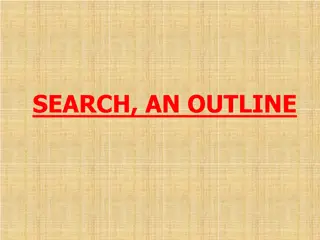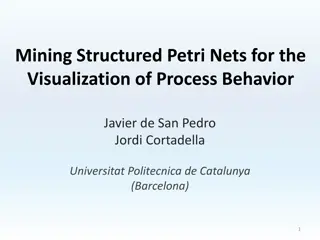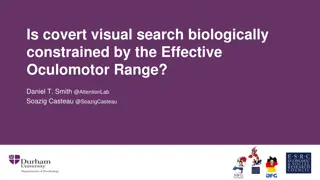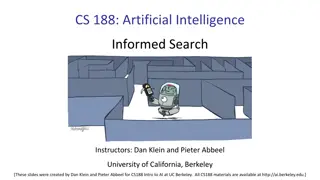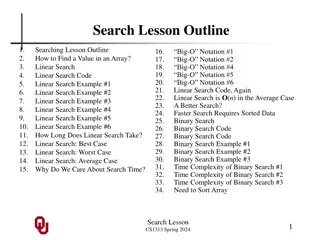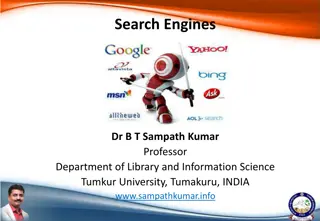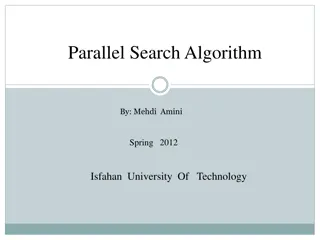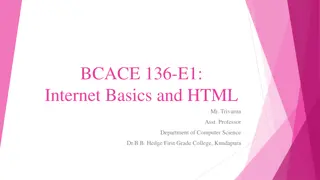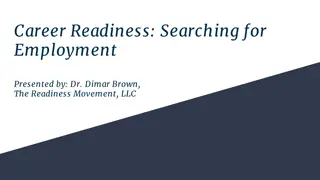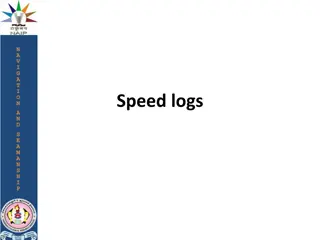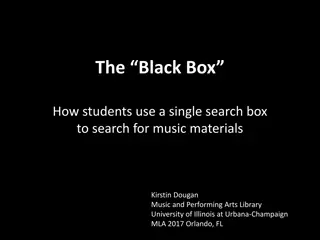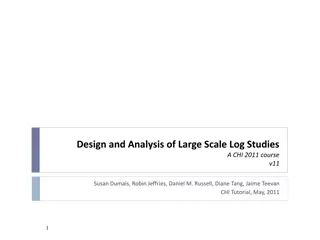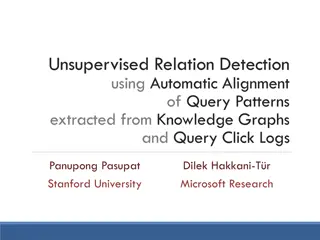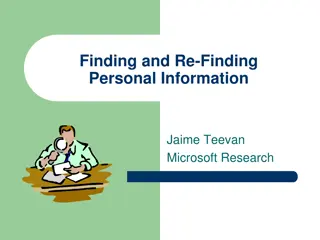Understanding Re-Finding Behavior in Yahoo Search Logs
Explore a study on re-finding behavior in Yahoo search logs, focusing on quantifying user re-finding actions, known patterns, methodology, and challenges in inferring re-finding intent. The research sheds light on the commonality and stability of re-finding, emphasizing the significance of identifying user behavior in search activities.
Download Presentation

Please find below an Image/Link to download the presentation.
The content on the website is provided AS IS for your information and personal use only. It may not be sold, licensed, or shared on other websites without obtaining consent from the author. Download presentation by click this link. If you encounter any issues during the download, it is possible that the publisher has removed the file from their server.
E N D
Presentation Transcript
Information Re-Retrieval Repeat Queries in Yahoo s Logs Jaime Teevan (MSR), Eytan Adar (UW), Rosie Jones and Mike Potts (Yahoo) Presented by Hugo Zaragoza
Whats the URL for this years SIGIR? http://www.sigir07.org http://www.sigir2007.com http://www.acm.org/sigir/2007 http://2007.sigir.org http://www.sigir2007.org http://www.acm.com/sigir/07 http://sigir.acm.org/07
Doesnt really matter Call for papers (Dec. 06) Submission instructions (Jan 07) Response date? (Apr. 07) Formatting guidelines (May 07) Proceedings (Jun 07) Travel plans/registration (Jul 07)
Overview Log analysis to: Quantify amount of re-finding behavior Understand types of re-finding Re-finding is very common Stability of results affects re-finding Possible to identify re-finding behavior
What Is Known About Re-Finding Re-finding recent topic of interest Web re-visitation common [Tauscher & Greenberg] People follow known paths for re-finding Search engines likely to be used for re-finding Query log analysis of re-finding Query sessions [Jones & Fain] Temporal aspects [Sanderson & Dumais]
Study Methodology Looked for re-finding in Yahoo s query logs 114 anonymous users Tracked for a year (average activity: 97 days) Users identified via cookie 13,060 queries and their clicks Log studies rich but lack intention Infer intention Supplement with large user study (119 users)
Inferring Re-Finding Intent Really hard problem No one to ask: what were you doing? But we can make some inferences Click on previously clicked results? Click on different results? Same query issued before? New query?
Click on previously clicked results? Click on different results? Same query issued before? Click on previously clicked results? Click on different results? Same query issued before? New query? New query?
Click on previously clicked results? Click same and different? Click on different results? Same query issued before? New query?
Click on previously clicked results? 1 click > 1 click Click same and different? Click on different results? Same query issued before? New query?
Click on previously clicked results? Click same and different? Click on different results? 39% 1 click > 1 click Navigational 3100 (24%) 36 635 (5%) 485 (4%) Same query issued before? (<1%) Re-finding with different query 637 (5%) 4 660 (5%) 7503 (57%) New query? (<1%)
How Queries Change Many ways queries can change Capitalization ( new york and New York ) Word swap ( britney spears and spears britney ) Word merge ( walmart and wal mart ) Word removal ( orange county venues and orange county music venues ) 17 types of change identified 2049 combinations explored Log data and supplemental study Most normalizations require only one type of change
Rank Change Reduces Re-Finding Results change rank Change reduces probability of repeat click No rank change: 88% chance Rank change: 53% chance Why? Gone? Not seen? New results are better?
Change Slows Re-Finding Look at time to click as proxy for Ease Rank change slower repeat click Compared with initial search to click No rank change: Re-click is faster Rank change: Re-click is slower Changes interferes and stability helps ?
Helping People Re-Find Potential way to take advantage of stability Automatically determine if the task is re-finding Keep results consistent with expectation Simple form of personalization Can we automatically predict if a query is intended for re-finding?
Predicting the Query Target For simple navigational queries, predict what URL will be clicked For complex repeat queries, two binary classification tasks: Will a new (never visited) result be clicked? Will an old (previously visited) result be clicked?
Predicting Navigational Queries Predict navigational query clicks using Query issued twice before Queries with the same one result clicked Very effective prediction 96% accuracy: Predict one of the results clicked 95% accuracy: Predict first result clicked 94% accuracy: Predict only result clicked
Predicting More Complex Queries Trained an SVM to identify If a new result will be clicked If an old result will be clicked Effective features: Number of previous searches for the same thing Whether any or the results were clicked >1 time Number of clicks each time the query was issued Accuracy around 80% for both prediction tasks
Future Work Experiment with different history mechanisms Given knowledge about re-finding intent, how do we best modify result pages? How to integrate new, better results? Contextual re-finding Re-finding varies by user Re-finding varies by time of day
Summary Log analysis supplemented by a user study Re-finding is very common Navigational queries are particularly common Categorized potential re-finding behavior Explored ways query strings are modified Stability of result rank impacts re-finding tasks Provided a first step in the solution by automatically classifying repeat queries to identify re-finding
Thank you! Questions? Jaime Teevan (MSR), Eytan Adar (UW), Rosie Jones and Mike Potts (Yahoo) Presented by Hugo Zaragoza





